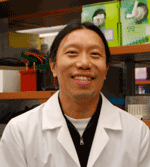 Associate Professor of Microbiology
Associate Professor of Microbiology
| Address: | 1825 University Blvd Shelby Building, 1202 UAB Birmingham, AL 35294 |
| Telephone: | 205-934-7037 |
| Email: | htse@uab.edu |
| Members of the Laboratory |
| Publications |
__________________________________________________________
Education
B.S. (Biochemistry), Virginia Polytechnic Institute and State University, Blacksburg, VA
Ph.D. (Microbiology and Immunology), University of Colorado Health Sciences Center, Denver, CO
Research Interests
The overall research objective in the Tse laboratory is to define and prevent immune-mediated effector mechanisms involved in the destruction of insulin-producing pancreatic beta-cells in autoimmune Type 1 diabetes (T1D). An overarching theme in our research is to determine the involvement of oxidative stress and the generation of reactive oxygen species (ROS) as effector and signaling molecules in autoimmune and pro-inflammatory-mediated diseases (Collagen-Induced Arthritis (CIA), Experimental Autoimmune Encephalomyelitis (EAE), Spinal Cord Injury, Traumatic Brain Injury). Research from our lab and others has shown that efficient T cell activation requires three signals mediated by antigen-presenting cell and naïve T cell interactions: signal 1 (T cell receptor – MHC), signal 2 (co-stimulatory molecules), and signal 3 (ROS and pro-inflammatory cytokines). To corroborate the importance of ROS-dependent signaling (signal 3) in T1D, a dominant negative p47phox (Ncf1m1J) mutation of the NADPH oxidase complex was introgressed into the non-obese diabetic (NOD) mouse, a murine model for studying Type 1 diabetes. NOD.Ncf1m1J mice are impaired in ROS synthesis and highly resistant to spontaneous diabetes and adoptive transfer of diabetes with diabetogenic T cells. CD4+ and CD8+ T cells are the final effector cells involved in pancreatic beta-cell destruction. Pro-inflammatory macrophages are equally important, as they constitute the first immune cells recruited into pancreatic islets to initiate beta-cell destruction and to activate naïve diabetogenic T cells. Currently, we seek to understand the synergy of oxidative stress and ROS synthesis on the activation of innate immune cells to diabetogenic viral triggers (Coxsackie B4, Encephalomyocarditis virus) and autoreactive T cells in murine models and human translational studies of Type 1 diabetes